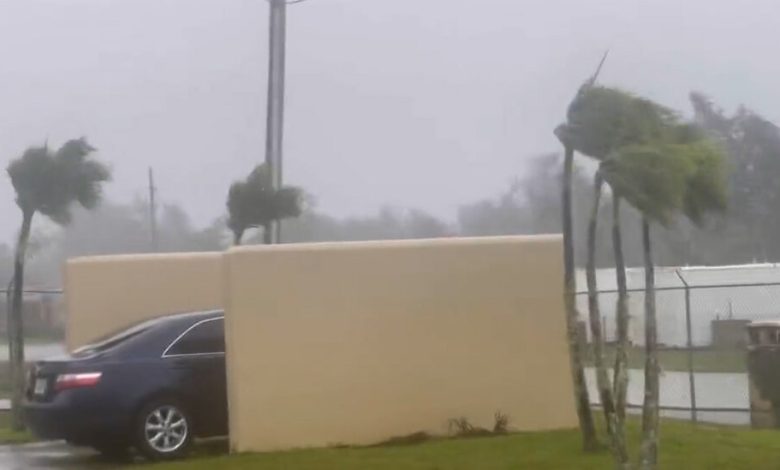Typhoon Mawar Lashes Guam With High Winds, Knocking Out Power

Typhoon Mawar crawled toward Guam on Wednesday afternoon, bringing hurricane-force winds that snapped trees and leaving most of the American territory without power, the authorities said.
The storm, with the force of a Category 4 hurricane, was the strongest to approach the Pacific island in years and could intensify by Wednesday evening, forecasters warned. The Guam Power Authority said that the island’s energy grid was providing power to only about 1,000 of its roughly 52,000 customers, and that it was too dangerous for repair crews to venture outside.
Mawar had not officially made landfall in Guam as of midafternoon, and it was possible that the island might be spared a direct hit, said Brandon Bukunt, a National Weather Service meteorologist in Guam. But the storm’s western eyewall had moved over the island, he added, and residents were already feeling typhoon-force winds.
In a sign of the storm’s strength, it broke the radar unit that sends storm imagery to Mr. Bukunt’s office, and the largest tree outside the office came crashing down in its driveway.
The 150,000 or so people who live on Guam, an island nearly the size of Chicago that sits about 1,500 miles east of the Philippines, are used to tropical cyclones. The last big one, Super Typhoon Pongsona, came ashore in 2002 with the force of a Category 4 hurricane and caused more than $700 million in damage.
In recent years, damage and deaths from major storms have been minimized in Guam because of stronger building codes and advanced warnings. In most cases, “We just barbecue, chill, adapt” when a tropical cyclone blows through, said Wayne Chargualaf, 45, who works at the local government’s housing authority.
But because it has been so long since Pongsona, “We have an entire generation that has never experienced this,” he added. “So a little bit of doubt started to creep into my mind. Are we really ready for this?”

Wind blowing in Guam on Wednesday, in a video grab from social media.Credit…James Reynolds, via Agence France-Presse — Getty Images
The center of the storm was about 40 miles east-southeast of Guam at about 1:30 p.m. on Wednesday, the Weather Service said in an update. The storm was moving northwest at about three miles per hour, and its impact was expected to peak in the early evening.
Mawar had weakened from Category 5 strength, but its maximum sustained winds were still pushing about 140 m.p.h., equivalent to those of a Category 4 hurricane, Mr. Bukunt said. Its southern eyewall was still offshore, but had the potential to bring even stronger winds to the island, along with torrential rains.
“Before we lost radar, that was where all the really nasty weather was,” he said.
President Biden declared an emergency for Guam on Tuesday night, allowing federal agencies to assist with relief efforts. By Wednesday, the island was firmly on an emergency footing, with evacuation orders, a flash flood warning and a halt to commercial aviation.
And at Andersen Air Force Base on Guam, all aircraft had either left the island ahead of the storm or been placed in hangars, the Air Force said in an email.
Tropical cyclones are called typhoons or hurricanes depending on where they originate. Typhoons, which tend to form from May to October, are tropical cyclones that develop in the northwestern Pacific and affect Asia. Studies say that climate change has increased the intensity of tropical cyclones, and the potential for destruction, because a warmer ocean provides more of the energy that fuels them.
Mawar, a Malaysian name that means “rose,” is the second named storm in the Western Pacific this season. The first, Tropical Storm Sanvu, weakened in less than two days.
Carlo Sgembelluri Pangelinan, 42, who sells container homes in a store in Barrigada Heights, a hilly, affluent neighborhood near Guam’s international airport, said he doubted the storm would be worse than anything he had lived through.
Still, Mr. Pangelinan added, he worried about people who did not have adequate shelter, and animals without owners to care for them, including stray dogs.
The island’s population is predominantly Catholic, and the Roman Catholic church in Guam said in a message to its congregants on Wednesday that the fear and anxiety permeating the island was understandable, in part because Super Typhoon Pongsona had left an “indelible impression” that could still be felt more than 20 years later.
“There is good that can be found amid storms,” the message said. “The kindness and care of people that emerge during such trials is one of them.”
John Yoon, Victoria Kim, McKenna Oxenden and Jin Yu Young contributed reporting.
